Extracting herbs with alcohol at home gives you a powerful way to capture and preserve beneficial plant compounds. You'll get better results than water-based methods since alcohol can extract both water-soluble and oil-soluble constituents from herbs. The process creates tinctures that remain potent for up to 5 years when stored properly, thanks to alcohol's natural preservative properties. Additionally, your body can absorb alcohol-based extracts more efficiently than other forms. With basic equipment like mason jars and high-proof vodka, you can create professional-quality herbal remedies. The journey into alcohol extraction opens up endless possibilities for your natural wellness toolkit.
Understanding Alcohol Extraction Benefits
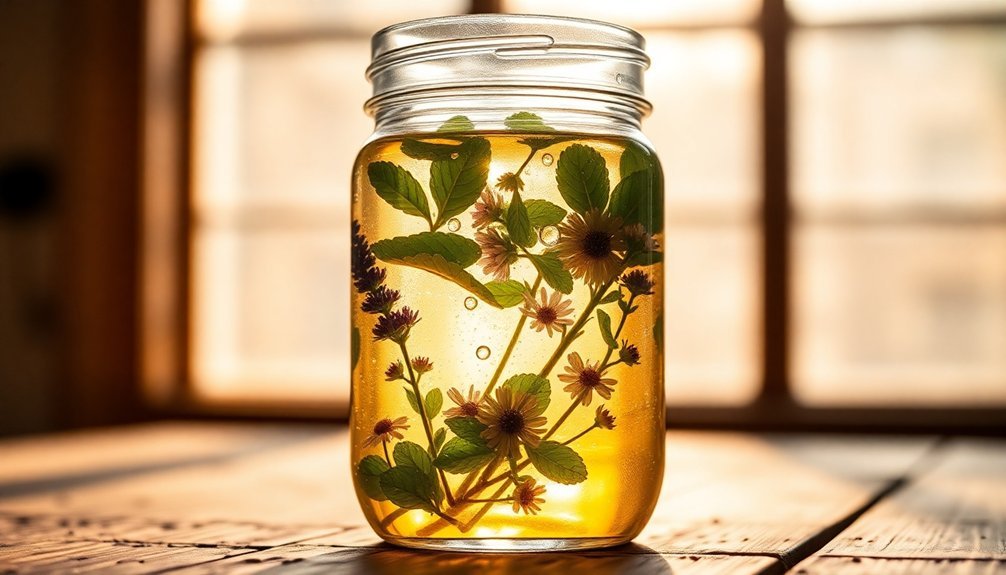
What's particularly valuable is the enhanced bioavailability of alcohol-based extracts.
Your body can absorb these liquid preparations more efficiently since they don't require breaking down plant cellulose.
Plus, you can combine alcohol with other solvents like vegetable glycerin to capture an even broader spectrum of beneficial compounds.
The high-proof alcohol allows for maximum extraction of active compounds from herbs while acting as a natural preservative.
Traditional Herbal Preservation Methods
Traditional herbal preservation techniques offer several reliable methods to maintain your herbs' potency and flavor long after harvest. Understanding these time-tested approaches can help you make the most of your herbal collection while ensuring maximum therapeutic benefits.
- When drying herbs, you'll want to harvest them just before their flowers open, during the bursting bud stage. Avoid direct sunlight during the drying process, as it can diminish both flavor and color. Instead, hang your herbs in a well-ventilated area or use paper bags with holes for tender-leaf varieties. Early morning harvesting after dew dries provides the best quality herbs for preservation.
- If you prefer freezing, you've got two efficient options: either fill ice cube trays with chopped herbs and water or spread them on a cookie sheet before transferring to an airtight container. Remember, once thawed, don't refreeze them.
- For controlled drying, your microwave or oven can work wonders. Different power settings and temperatures can actually help retain or even increase beneficial compounds like phenolics and flavonoids.
- Consider trying osmotic dehydration as a pre-treatment step, or explore vacuum and freeze-drying methods if you're looking for superior color and structure preservation.
Always store your preserved herbs in airtight containers to prevent moisture and microbial growth.
Solvent Power of Alcohol
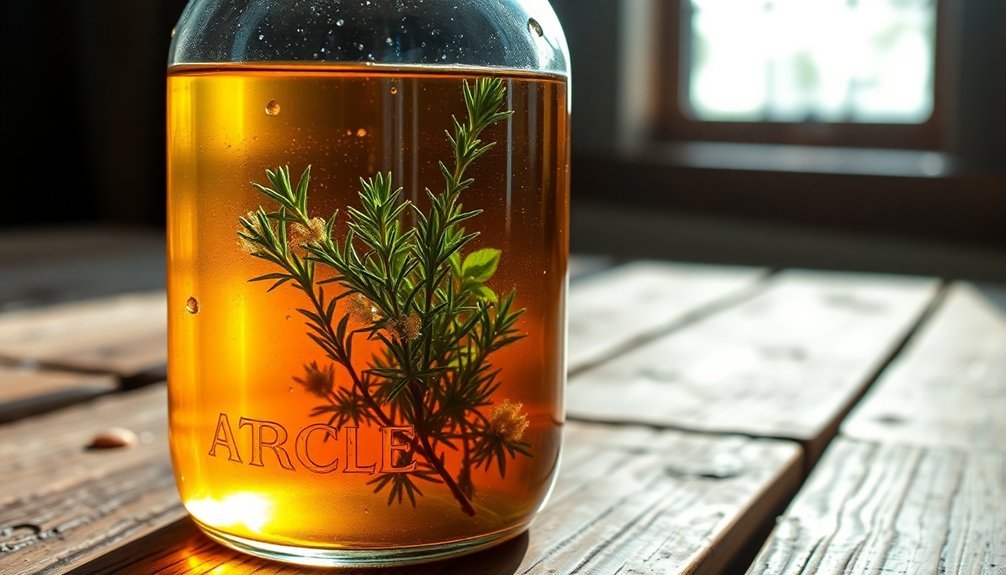
Alcohol's unique molecular structure gives you an incredible tool for extracting both water-soluble and oil-soluble compounds from herbs.
You'll find that alcohol's dual nature – its polar and nonpolar properties – allows it to pull out a wide range of plant constituents that water alone can't touch.
The solvent breaks through plant cell walls to release valuable compounds like alkaloids, essential oils, and resins, making them available in your tincture. A 1:4 ratio of dried herbs to alcohol produces optimal extraction results.
Alcohol's Molecular Extraction Power
Since ancient times, the molecular power of ethanol has made it one of nature's most effective solvents for extracting beneficial compounds from herbs. When you use alcohol to extract herbs, you're tapping into its remarkable ability to pull out a wide range of bioactive molecules, from alkaloids to tannins and resins.
Alcohol's unique properties allow it to extract both water-soluble and alcohol-soluble compounds, making it incredibly versatile for herbal preparations.
You'll find alcohol particularly effective because:
- It efficiently extracts polyphenols, anthocyanins, and other compounds that aren't easily soluble in water alone.
- It can combine with water in various ratios to optimize the extraction of different herbal constituents.
- It preserves the medicinal properties of herbs better than other extraction methods.
- It creates highly concentrated extracts that require only small amounts to be effective.
The molecular extraction power of alcohol means you'll get more from your herbs than with water alone.
When you combine alcohol with water, you're creating a powerful solvent system that can extract a broader spectrum of beneficial compounds, resulting in more potent and effective herbal preparations.
Nonpolar and Polar Properties
Understanding the dual nature of alcohol as both a polar and nonpolar solvent reveals its remarkable extraction capabilities. When you're using high-proof alcohol (95% or higher), you'll effectively extract nonpolar compounds like essential oils, resins, and volatile oils from herbs such as Thyme, Oregano, and Rosemary.
Alcohol's nonpolar properties make it ideal for dissolving lipophilic compounds, including alkaloids and glycosides, which are essential for medicinal benefits.
You'll find that alcohol's versatility extends to its polar properties as well. When combined with water, it can extract certain polar compounds like mucilage and polysaccharides.
You'll get the best results using different alcohol concentrations for different herbs – higher percentages (40-60%) work well for most herbs, while lower percentages (25-35%) are better for polar compounds. The hydroalcoholic mixture in your tinctures, whether from vodka, brandy, or fresh plant material, allows for broader extraction capabilities.
Additionally, you'll benefit from alcohol's preservation properties, which maintain the potency of both polar and nonpolar constituents, ensuring your tinctures remain effective for up to five years or more.
Breaking Plant Cell Walls
Inside each plant cell, rigid walls composed of cellulose, hemicellulose, and lignin create a natural barrier that you'll need to break through for effective extraction.
These walls protect the valuable compounds within, but alcohol helps you access them by disrupting the complex bonds that hold everything together.
When you use alcohol as your extraction medium, you're taking advantage of its unique ability to break down cellular structures. The alcohol works by:
- Disrupting hydrogen bonds between cell wall components, making it easier to access the plant's beneficial compounds
- Penetrating both water-soluble and non-water-soluble components, guaranteeing you get a complete extraction
- Creating enlarged pores in the cell walls, which allows better access to the plant's internal contents
- Working synergistically with heat to increase the extraction efficiency
You'll get the best results by matching your alcohol proof to your plant material.
Use higher proof alcohol for plants with fewer water-soluble components, and lower proof for those with more.
Remember to take into account the ratio of plant material to alcohol – use 1:1 for fresh herbs and 1:4 for dried herbs to achieve the best extraction of beneficial compounds.
Maximizing Herbal Extract Potency
The quest for maximum potency in herbal extracts requires a strategic combination of techniques and careful attention to extraction methods.
You'll want to focus on using the right alcohol concentration for your specific herbs, as different plants require varying proofs to extract their beneficial compounds effectively. High-proof alcohol (80-100 proof or 180 proof) works best for extracting both water-soluble and fat-soluble constituents.
To optimize your extracts, you can employ various techniques like maceration, percolation, or heat-assisted extraction.
You'll find that combining methods often yields better results – for instance, using dual-phase extraction can help you capture more bioactive compounds.
When you're working with delicate herbs, consider using glycerin alongside alcohol to preserve the therapeutic properties while reducing alcohol content.
Don't forget to adjust your dosage and frequency based on the concentration of your extract.
You can enhance potency by adding synergistic herbs or carrier oils to your formulation.
Remember to tailor your extraction process to each specific plant's chemical composition – what works for one herb mightn't work for another.
Essential Equipment and Supplies
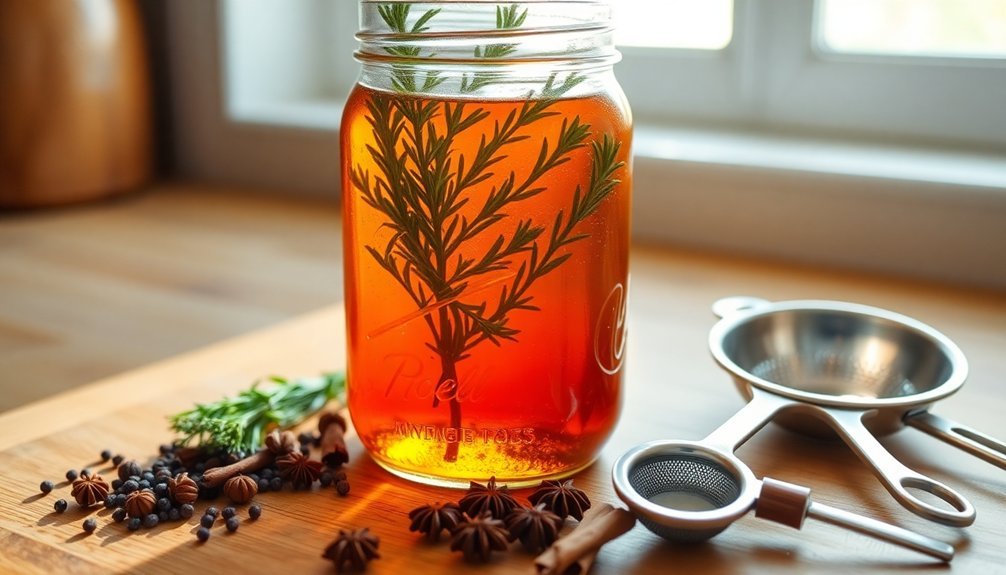
You'll need several basic tools and containers to get started with home alcohol extraction, including mason jars, funnels, and strainers.
Your essential measuring and safety equipment should include a digital scale, protective gloves, safety goggles, and a thermometer to monitor temperatures during the process.
When selecting alcohol, opt for food-grade ethanol or high-proof vodka (at least 80 proof) as your extraction solvent, ensuring you're using a pure, consumable base for your herbal extracts.
Basic Tools and Containers
Gathering the right tools and containers stands as a crucial first step for successful herb extraction with alcohol. You'll need clean, airtight glass jars that won't react with your solvents or herbs. These containers must remain completely dry and sealed to prevent any contamination during the maceration process.
For precise measurements and efficient processing, you'll want to equip yourself with basic tools that guarantee accuracy and ease of use:
- A reliable scale to measure your herbs and maintain consistent ratios
- A thermometer to monitor temperatures during the extraction process
- A funnel to help transfer materials without waste or spillage
- Clean, sharp tools for coarsely chopping your herbs
If you're planning to use an extraction appliance, you'll benefit from modern features like Bluetooth connectivity and app controls. These smart devices operate under vacuum with low heat, making the process safer and more efficient.
Whether you choose traditional distillation equipment or contemporary extraction appliances, your setup should include proper heating elements and a water source. Remember that copper, glass, or stainless steel equipment offers different benefits for various extraction methods, so choose based on your specific needs.
Measuring and Safety Equipment
Safety-conscious preparation demands specific measuring tools and protective gear when extracting herbs with alcohol. You'll need accurate scales for weighing herbs, measuring cups for liquids, and a thermometer to monitor extraction temperatures. A pH meter can help you maintain ideal acidity levels, while graduated cylinders guarantee precise measurements throughout the process.
Your safety equipment must include protective gloves, safety goggles, and proper ventilation to prevent exposure to fumes. Keep a fire extinguisher nearby due to alcohol's flammability, and maintain a well-stocked first aid kit for emergencies.
| Essential Equipment | Primary Purpose | Safety Level |
|---|---|---|
| Digital Scales | Precise herb measurement | Standard |
| Safety Goggles | Eye protection | Critical |
| Ventilation System | Fume control | Critical |
| Protective Gloves | Skin protection | High |
| First Aid Kit | Emergency response | Critical |
When working with alcohol-based extractions, you'll want to establish a dedicated workspace with all measuring and safety equipment within easy reach. Don't skip essential safety measures, as they protect you from potential chemical exposure and accidents. Remember to regularly check and maintain your equipment, guaranteeing accurate measurements and ideal safety conditions throughout the extraction process.
Alcohol Selection Guide
Successful herbal extraction begins with choosing the right alcohol concentration and type. When you're working with herbs at home, you'll need to match the ethanol percentage to your specific plant materials.
Different compounds require varying alcohol strengths – water-soluble components need 25% ethanol, while resins demand up to 90%.
For most home extractions, you'll want to aim for 40-60% ethanol concentration, as this range effectively captures a broad spectrum of plant compounds. This means you can use common spirits like vodka or adjust higher-proof alcohol with water to achieve your target percentage.
- Match your alcohol strength to your herb type: 25% for water-soluble compounds, 45-60% for essential oils and alkaloids, and 90% for resins
- Consider using the folk method for simple preparations, especially when starting out
- Maintain a 1:1 ratio for fresh herbs and 1:4 for dried materials
- Store your tinctures properly to benefit from alcohol's natural preservative properties
Alcohol Percentage and Herb Ratios
Creating effective herbal tinctures requires precise alcohol percentages and herb-to-solvent ratios. You'll need to use alcohol between 40-60% ABV for most herbs, though some constituents require higher concentrations.
Fresh plants, resins, and volatile oils work best with 95% ABV, while mucilage and polysaccharides extract better in lower alcohol percentages.
When measuring your herbs and alcohol, you'll want to follow standardized ratios. A common ratio is 1:5, meaning one part herb to five parts solvent. For example, you'd use 10 grams of dried herb with 50ml of solvent.
Fresh herbs typically need a stronger 1:2 ratio due to their higher water content.
To achieve the right alcohol percentage, you'll need to dilute high-proof alcohol with distilled water. For instance, if you're aiming for 40% ABV, combine 4.5 cups of 95% alcohol with 5.5 cups of water for a 10-cup mixture.
Remember that different plants require different ratios and alcohol percentages based on their constituents. For resins and volatile oils, you'll need 70-95% ABV, while tannin-rich herbs might benefit from adding vegetable glycerin for stability.
Fresh Versus Dried Herbs
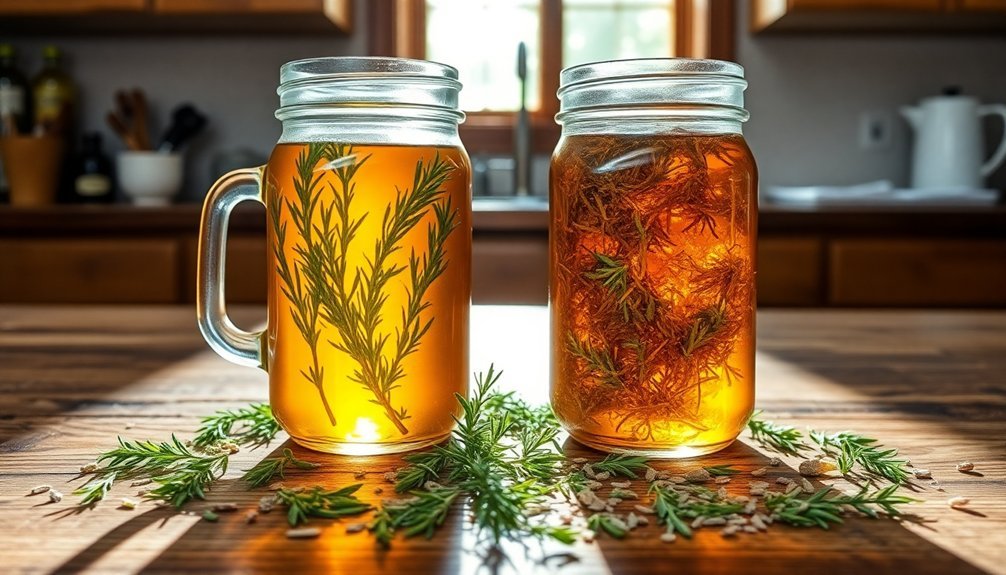
When deciding between fresh and dried herbs for your tinctures, you'll need to contemplate several key factors that affect extraction quality. While fresh herbs contain vibrant energy and potent properties, their high moisture content can interfere with proper alcohol extraction, especially for lipophilic compounds. Dried herbs, on the other hand, offer better extraction efficiency and more concentrated constituents due to moisture removal.
- Fresh herbs require immediate processing and have limited shelf life, making them less practical for long-term tincture making. They're best used for specific herbs like ginger, turmeric, and garlic, where fresh properties are essential.
- Dried herbs allow for better control over alcohol strength in your tinctures since you won't need to account for additional moisture content from the plant material.
- You'll achieve more consistent results with dried herbs as they're more stable and their constituents are concentrated through the drying process.
- If you're working with woody herbs like oregano, thyme, or rosemary, you'll get better results using them in their dried form, as these herbs maintain their properties well through the drying process.
Step-by-Step Extraction Process
The art of herb extraction follows a methodical process that assures maximum potency and quality in your final tincture.
You'll need to begin by cutting or grinding your herbs into small pieces to maximize their surface area for better extraction. Make sure you've sanitized all your equipment, including the glass jar and utensils.
Next, you'll combine your herbs with alcohol using specific ratios: 1:5 for dried herbs or 1:2-1:3 for fresh herbs. Choose alcohol that's 40-50% ABV for most herbs, though you might need higher proof alcohol (70-95% ABV) for extracting resins. Assure your herbs are completely submerged in the solvent to prevent oxidation.
Store your mixture in a cool, dark place for 2-6 weeks. You'll need to shake it daily during the first week, then regularly afterward. This consistent agitation helps extract the plant's beneficial compounds, including alkaloids, tannins, and resins.
Finally, strain your extract through a muslin cloth or unbleached coffee filter. If you notice any remaining sediment, filter it a second time.
Transfer your finished extract to a dark glass bottle and don't forget to label it with the date and ingredients.
Storage and Shelf Life
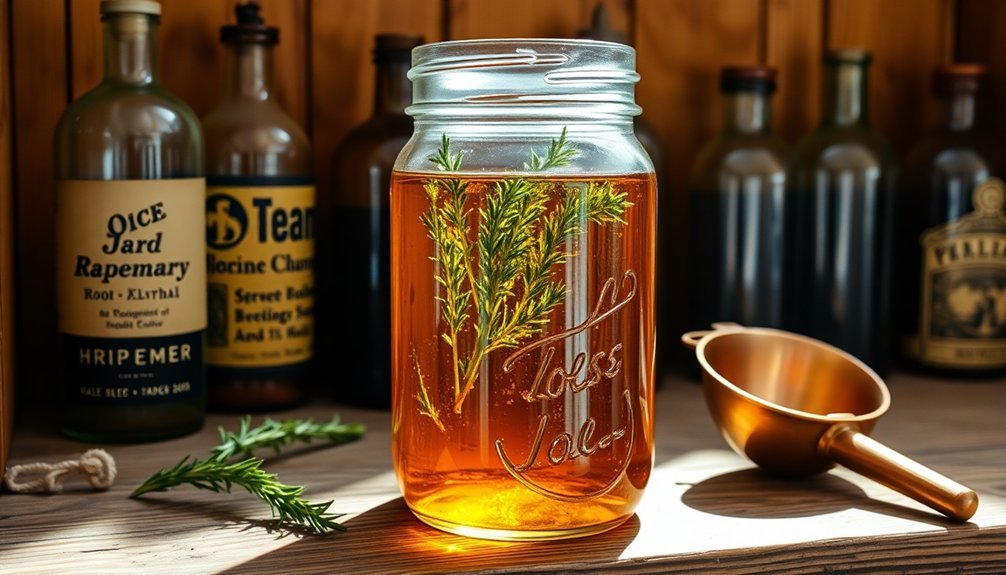
Proper storage practices make the difference between a long-lasting herbal tincture and one that quickly loses potency.
You'll want to store your tinctures in a cool, dark place away from direct sunlight and heat sources to maintain their therapeutic properties. When you're selecting containers, opt for brown or blue glass bottles with tight-fitting lids, as they'll protect your tincture from light damage and prevent contamination.
- Strain your tincture thoroughly after the 4-6 week extraction period using cheesecloth or a fine mesh strainer, making sure to squeeze out all the liquid from the herbs before discarding them.
- Transfer your strained tincture into clean, dry glass bottles, avoiding metal lids that might rust and compromise the solution.
- Label each bottle clearly with the contents, preparation date, and any other relevant information to track shelf life.
- Store your tinctures in a stable environment where temperature doesn't fluctuate, and check them periodically for signs of spoilage.
When you follow these storage guidelines properly, your tinctures can maintain their potency for several years.
Keep them away from children and pets, and always guarantee your storage area remains consistent in temperature and lighting conditions.
Safety and Quality Control
Making herbal tinctures at home demands careful attention to safety protocols and quality control measures. You'll need to accurately identify your plant materials and understand their potential toxicity before beginning any extraction process. Always verify your herbs come from reliable sources and are free from contamination.
| Safety Aspect | Quality Control Measure |
|---|---|
| Plant Identity | Use verified suppliers and botanical guides |
| Contamination | Clean equipment, sterile containers |
| Alcohol Ratio | Match proof to herb constituents |
| Documentation | Record methods and observations |
You'll need to select the appropriate alcohol concentration based on your herb's specific constituents. Using 80-proof vodka works well for many water-soluble compounds, while 180-proof alcohol is necessary for resins and essential oils. If you're reducing alcohol content, monitor temperature carefully to prevent degrading the active compounds.
Keep detailed records of your process, including the herb-to-alcohol ratios, extraction time, and any modifications you make. You should test small batches first and observe any reactions before scaling up. Remember that improper extraction methods can either render your tincture ineffective or potentially harmful, so following established protocols isn't just good practice—it's essential for safety.
Using Your Herbal Extracts
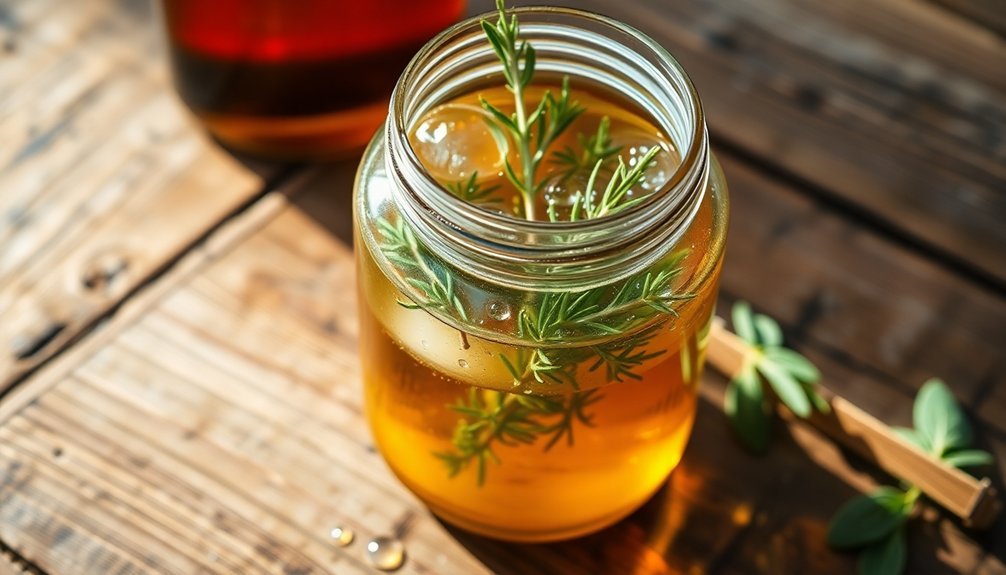
Successfully crafting herbal extracts opens up a world of therapeutic possibilities, from direct consumption to creative applications in daily wellness routines. You'll find these versatile preparations can be taken directly using a dropper or mixed into your favorite beverages and foods.
Whether you're treating acute conditions like colds and fevers or managing chronic health issues, your homemade extracts can serve multiple purposes.
- You can transform your extracts into healing elixirs by combining them with other botanical preparations, creating custom blends for specific health needs like stress management or immune support.
- For external use, you'll be able to incorporate your extracts into topical applications, making your own creams, lotions, and salves for pain relief or skin conditions.
- You can create specialized tinctures for targeted benefits – think valerian for sleep, ginseng for energy, or black cohosh for hormonal balance.
- Your extracts will maintain their potency for years when properly stored in airtight glass containers away from sunlight, with alcohol-based tinctures lasting up to 5 years and vinegar-based preparations enduring 6 months to a year.
Frequently Asked Questions
Can I Use Flavored Alcohols Like Vanilla Vodka for Herbal Extractions?
You shouldn't use vanilla vodka or other flavored alcohols for herbal extractions. The flavorings can interfere with the herbs' medicinal properties, reduce extraction efficiency, and compromise preservation. Stick to pure, unflavored alcohol instead.
What Herbs Should Never Be Extracted With Alcohol?
You shouldn't extract fresh ginger or turmeric with alcohol due to their high moisture content. Also avoid herbs that require extremely high alcohol concentrations (90%+) as they're difficult to extract properly at home.
Does Moonshine or Homemade Alcohol Work for Making Herbal Tinctures?
Yes, both moonshine and homemade alcohol can effectively create herbal tinctures. You'll get great results with their high proof content, which helps extract plant compounds and preserves your tinctures for long-term use.
Can I Mix Different Herbs in the Same Alcohol Extraction?
You can mix different herbs in one alcohol extraction, but you'll need to carefully consider their compatibility, extraction times, and potential interactions. It's best to start with single-herb tinctures until you're more experienced.
Should I Filter My Tincture Multiple Times or Just Once?
You'll want to filter your tincture multiple times to guarantee complete removal of all particles. Start with a coarse filter, then use progressively finer filters until your tincture's completely clear and sediment-free.
In Summary
Making your own herbal extracts with home alcohol puts you in control of your herbal medicine. You'll save money, guarantee quality ingredients, and create potent tinctures that can last for years. Whether you're preserving garden herbs or crafting specific remedies, alcohol extraction offers a reliable, time-tested method. Start with basic equipment and safe practices, and you'll soon be producing effective herbal preparations at home.

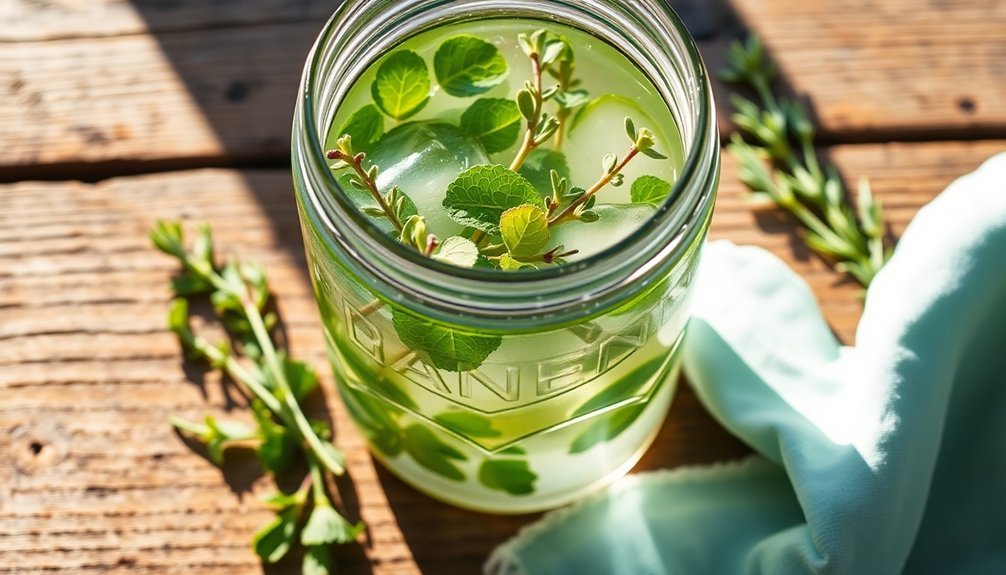



Leave a Reply